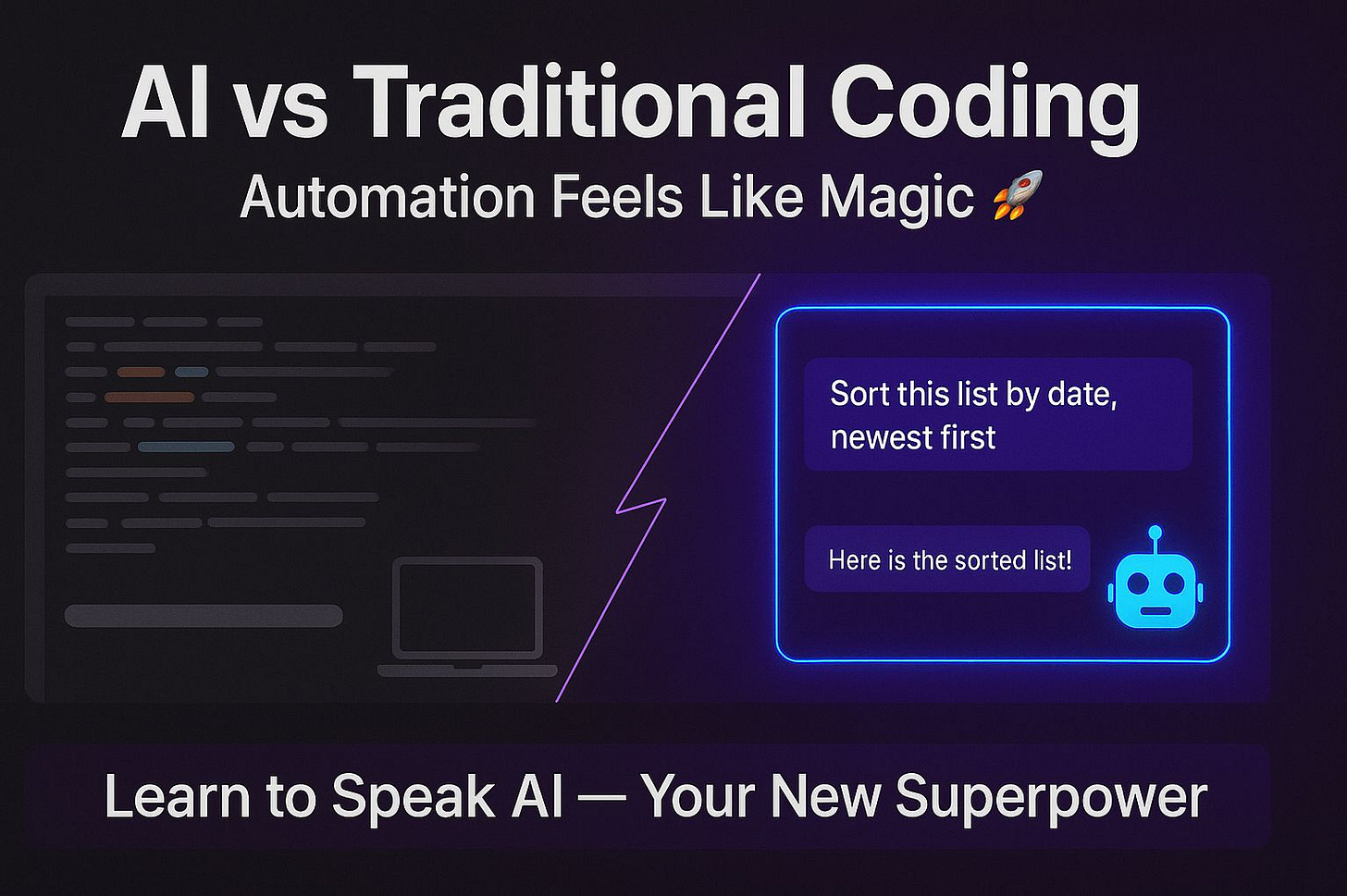AI vs Traditional Coding: Why Automation Feels Like Magic
From writing every line manually to letting AI handle the heavy lifting — exploring the new era of coding
Introduction: remembering handwritten homework
Most of us grew up solving math problems by hand until a teacher introduced us to calculators. Suddenly, tedious arithmetic became a button press and our brains were freed to focus on the bigger concepts. A similar shift is unfolding in software development. Traditional coding feels like manually crunching numbers on paper; AI‑powered tools feel like discovering the calculator all over again — only this time, the calculator speaks code.
Traditional coding: the step‑by‑step craft
Coding has long been an exercise in precision. You write a function, tell the computer how to sort a list or process data, and it follows your instructions exactly. Every parenthesis, semi‑colon and logic branch matters. This meticulousness gives developers fine‑grained control but also ties up their time in repetitive tasks.
The classic way to sort a list, for example, involves writing the comparison logic, handling edge cases and testing extensively. The developer is responsible for every detail. It’s like building a road brick by brick.
AI‑powered coding: describe the intent, let the machine fill in the gaps
AI coding assistants such as GitHub Copilot leverage large language models to provide code suggestions and completions across a wide range of tasks. They can suggest a block of code, generate tests, refactor functions or explain unfamiliar snippets. Instead of writing a sorting function, you might simply instruct the assistant: “Sort this list by date, newest first,” and it generates the appropriate code for you.
These systems are integrated into the developer’s environment. You type comments in natural language and they respond with context‑aware code. According to a study of user perceptions, AI assistants accelerate software development and reduce workloads, and most users love the way these tools handle boilerplate tasks.
Why developers say AI feels magical
Feedback from thousands of developers suggests that AI assistants genuinely boost productivity. In a recent analysis of user reviews, 90 % of statements labelled “productivity” expressed positive sentiment. People frequently describe how these tools streamline their workflow, reduce repetitive typing and improve efficiency — “not having to type every single repetitive function or import”.
Another academic study looking at neural code completion found that products like GitHub Copilot, Kite and TabNine are explicitly designed to increase user productivity. When researchers surveyed over 2,600 developers, they learned that the rate at which suggestions are accepted is a strong predictor of perceived productivity. In other words, when the assistant’s code “clicks” with the developer’s intent, it really does feel like magic.
Saving time: fewer errors, more focus
AI tools cut down on time spent fighting syntax errors or searching Stack Overflow. They can generate repetitive boilerplate code or produce unit tests with a single comment. This frees developers to focus on architecture and user experience rather than the tiny details.
One user study found that the ability to customise language preferences and suggestion styles was nearly as important to productivity as accurate suggestions. Allowing the assistant to align with your coding style not only makes the suggestions more useful but also enhances confidence in the generated code.
The limits: why AI isn’t a silver bullet
AI‑powered coding is not perfect, and understanding its limitations is crucial. Studies show that developers still spend significant time verifying AI‑generated suggestions. One research team observed that coders may spend over 50 % of their coding time checking AI‑generated code, which increases cognitive load. This means AI can speed you up on routine tasks, but it can also slow you down if you blindly accept suggestions without review.
Experiments also reveal mixed results about overall speed. In a randomized controlled trial with experienced open‑source developers, participants who were allowed to use AI tools took 19 % longer to complete their tasks than those who wrote code unaidedmetr.org. Developers expected AI to make them 24 % faster, and even after finishing the experiment they still believed AI had sped them up, despite the measured slowdownmetr.org. Such findings suggest that the perception of productivity may not always match reality.
There are other trade‑offs:
Accuracy and redundancy. Users praise accurate suggestions but become frustrated with redundant or buggy outputs. Inaccurate code can waste time and erode trust.
Context awareness. AI assistants understand code well once the relevant context is loaded, but they often struggle to retrieve or maintain that context. For example, forgetting definitions in other files or losing track of previous instructions can lead to confusing suggestions.
On‑boarding and usability. Some tools require complex setup or have unintuitive interfaces. Users in one study complained that more features often meant a steeper learning curve.
Data privacy and security. Relying on cloud‑based models raises concerns about exposing proprietary code or sensitive algorithms.
Despite these limitations, the underlying technology is improving rapidly, and thoughtful usage can mitigate many issues. Treat AI suggestions as a starting point, not gospel. Review and refine them just as you would a colleague’s code review comments.
People + AI: supercharging, not replacing
With all the hype around generative AI, some worry that machines will replace human programmers. The evidence suggests otherwise. Experienced developers in a controlled trial didn’t gain significant speedupsmetr.org, and many still found certain tasks slowed down. Meanwhile, the same study on developer perceptions found that novices often benefit more than seasoned professionals.
AI coding assistants are best viewed as an augmentation tool — they can generate boilerplate, summarise code, translate between languages and highlight potential bugs. However, they lack the human ability to understand the problem domain, empathise with users or design creative solutions. Developers who learn how to prompt these tools effectively will gain a powerful ally. Those who ignore them risk falling behind when routine work becomes automated.
The technology will evolve quickly. Current limitations around context, memory and reliability will shrink. But for the foreseeable future, people remain at the centre of software development. AI will replace repetitive tasks, not the creative humans who guide the process. Learning to “speak AI” is your new superpower.
Conclusion: embrace the magic responsibly
The transition from traditional coding to AI‑powered automation feels as revolutionary as going from longhand arithmetic to calculators. Today’s tools can write boilerplate, refactor code, generate documentation and even suggest architectures, saving you time and freeing you to think about the bigger picture. Yet they are far from perfect — they demand your judgment, require careful verification and sometimes even slow you down.
Treat AI as a collaborator. Let it handle the mundane parts of coding while you focus on solving real problems. Stay curious, experiment with different prompts and continue honing your craft. Automation feels like magic because it is the result of decades of research and engineering — but behind every magic trick is a magician who knows how it works.




